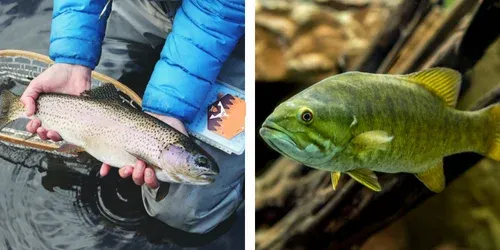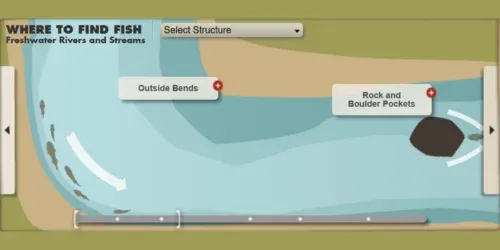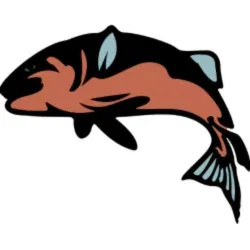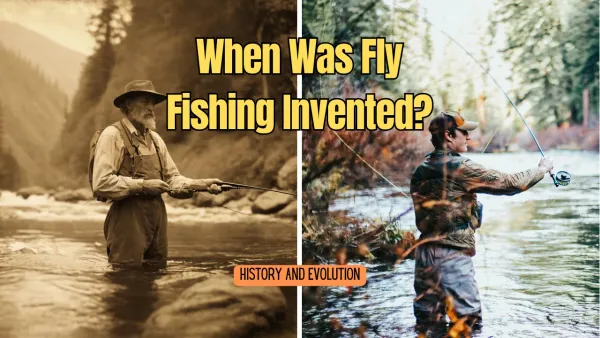An Introduction to River Fishing
There's something magical about standing in the middle of a flowing river, surrounded by hillsides and trees. The sound of rushing water and the cool breeze on your face is invigorating. But, river fishing is not just about the scenic beauty.
River fishing is a challenging and exciting way to catch fish. Unlike fishing in still waters like lakes or ponds, river fishing offers a unique set of challenges. The water is constantly moving, and fish in rivers are generally more active and challenging to catch.
Whether you're a seasoned angler or a newcomer to the sport, fishing in a river can provide you with unforgettable fishing opportunities. In this article, we'll go in-depth about river fishing, including different types of rivers, popular species of fish, essential gear, tips, and safety precautions. So, grab your fishing gear, and let's explore what river fishing is all about!

Popular Species of Fish Found in Rivers
Rivers are home to a diverse range of fish species, making it a popular destination for anglers. Here are some of the most common species of fish you can catch while river fishing:
Trout
Trout is one of the most popular game fish in the world, and rivers are one of their natural habitats. Rainbow trout, brown trout, and brook trout are three of the most common types of trout found in rivers. They can be found in both cold and warm water, depending on the species.
Bass
Bass is another popular game fish that can be found in many rivers. Smallmouth bass and largemouth bass are two of the most common types of bass you can catch while river fishing. They prefer clear water and can be found near areas with submerged rocks or logs.
Catfish
Catfish are bottom-dwelling fish that can be found in almost any type of river. They are often caught using live bait such as worms or cut bait. Flathead catfish and channel catfish are two of the most common catfish species you can catch in rivers.
Panfish
Panfish is a term used to describe a variety of small-sized fish that are exceptionally easy to catch. Examples of panfish include bluegill, crappie, and sunfish. These fish are often found near structures such as fallen trees or brush piles.
Pike
Northern pike is a predatory fish that can be found in many rivers. These fish are most commonly caught using artificial lures. They are known to put up a fight and can be challenging to reel in due to their sharp teeth.
River fishing provides an opportunity to catch a wide variety of fish species while enjoying the beauty and peacefulness of nature. Different fish species thrive in different types of rivers, and having knowledge of the habitat and feeding habits of the specific species you're targeting can increase your chances of a successful fishing trip.

Different Types of Rivers for Fishing
Rivers come in different shapes and sizes, and each type of river offers a unique fishing experience. Here are some of the different types of rivers for fishing:
Large Rivers
Large rivers, like the Mississippi River, are typically classified as rivers that are over 100 feet wide. These rivers are often characterized by fast currents, deep pools, and a variety of underwater structures. Due to the size of these rivers, anglers can expect to catch a wide range of fish species, including catfish, bass, trout, and walleye. Fishing in large rivers typically requires heavier gear and lures due to the strong currents and deep waters.
Small Rivers
Small rivers, like most of those found in the Western United States, are usually rivers that are less than 40 feet wide. These rivers are often characterized by slower currents and shallow waters. Small rivers are ideal for fly fishing, as the slower currents make it easier to cast and target fish. You can expect to catch species like trout, smallmouth bass, and panfish in small rivers.
Mountain Streams
Mountain streams are typically located in mountainous regions and are characterized by fast, narrow currents and rocky terrain. These streams are known for their crystal-clear waters and wild trout populations. Fishing in mountain streams is often challenging due to the swift currents and tight fishing spaces.
Spring Creeks
Spring creeks are narrow, meandering streams that are fed by underground springs. These creeks are often characterized by clear, slow-moving waters and are known for their wild trout populations. Fishing in spring creeks requires a stealthy approach as the clear water and slow currents mean that fish will easily spook if they sense danger.
Tailwater Rivers
Tailwater rivers are rivers that are downstream from a dam. The dam releases water at a consistent temperature, providing a stable environment for fish to thrive in. You can expect to catch a wide range of fish species in tailwater rivers, including trout, bass, and catfish.
Overall, each type of river offers a unique fishing experience, with different fish species and challenges. Understanding the characteristics of the river you're fishing in will help you choose the right gear and techniques to increase your chances of a successful fishing trip.

Best Times for River Fishing
Timing is everything when it comes to river fishing. Different fish species are more active at specific times of the day or night, and some fish species are more abundant during certain seasons. Here are some tips on the best times for river fishing:
Early Morning and Late Evening
Anglers often prefer to fish during the early morning and late evening hours, also known as the "golden hours." During these times, fish tend to be more active and are more likely to bite. This is especially true during the summer months when water temperatures are warmer throughout the day.
Cooler Weather and Water Temperatures
Fish are more active during cooler weather and water temperatures. During the hot summer months, water temperatures can become too warm, causing fish to become lethargic and less likely to bite. Fishing during the cooler parts of the day, such as early morning or late evening, can help increase your chances of catching active fish.
Spring and Fall Seasons
Spring and fall are often considered the best seasons for river fishing. During the spring, fish are feeding vigorously after the long winter months, and in the fall, they are preparing for the upcoming winter season. Additionally, during these seasons, water temperatures are cooler, which makes fish more active.
Rainy or Overcast Days
Rainy or overcast days can be an excellent time to go river fishing. The low light conditions and cooler water temperatures can trigger fish to feed more actively. Fish also tend to move closer to the surface of the water on cloudy days, making them easier to catch.
Full Moon
The full moon can have an impact on fish behavior, making them more active during the night. Fish tend to feed more frequently during the full moon, making it an excellent time for night fishing.
In conclusion, timing can significantly impact your chances of a successful river fishing trip.
Understanding the best times for river fishing based on the weather, water temperature, and fish species behavior will help you increase your chances of catching fish. It's always a good idea to hit the local tackle shop. Store owners always appreciate you spending a little money in their shop and if you chat them up while you're in the shop, they might share some local knowledge on what's biting, what lures/bait to use, and some good places to go. Don't expect them to give up the location of their honey hole, though!

Essential Gear Needed for River Fishing
Having the right gear is crucial for a successful and enjoyable river fishing experience. Here are some of the essential items you'll need:
Fishing Rod and Reel
A fishing rod and reel are essential for any fishing trip, and river fishing is no exception. When selecting a fishing rod and reel, consider the fish species you're targeting, the type of river you'll be fishing in, and your personal preference. If you're going after trout, consider a 4wt or 5wt fly rod or a light or medium-light spin cast rod. If you're chasing bass, beef it up with a medium-light to medium-weight rod.
Fishing Line
Your fishing line should be strong enough to handle the weight and fighting power of the fish species you're targeting. Monofilament and braided lines are two popular options for river fishing. Monofilament lines are stretchy, making them ideal for casting and fishing in snag-prone rivers, while braided lines have no stretch, making them more sensitive and better for fishing in wide-open rivers.
Hooks and Sinkers
Hooks and sinkers are essential for baiting and weighing down your fishing line. The size and weight of your hooks and sinkers will vary depending on the fish species you're targeting and the type of river you're fishing in. Split shot sinkers are commonly used in rivers, as they can be added or removed from the line to adjust the weight.
Lures and Bait
Lures and bait are used to attract fish to your fishing line. When selecting lures or bait, consider the fish species you're targeting and the type of river you're fishing in. Worms, grubs, and baitfish are popular bait options for river fishing, while spinners, jigs, and crankbaits are popular lure options.
Fishing Vest
A fishing vest is a convenient way to carry and organize your fishing gear, including hooks, lures, and sinkers. Look for a vest with multiple pockets and compartments for easy access to your gear.
Protective Gear
Protective gear, such as sunglasses, sun hats or caps, and sunscreen are essential for protecting yourself from the sun's harmful rays. Polarized sunglasses are particularly useful as they can help reduce glare on the water, making it easier to spot fish.
Having the right gear can significantly impact your river fishing experience. By investing in essential gear and understanding the specific gear requirements for the fish species and type of river you'll be fishing in, you'll be better equipped to catch your desired catch while enjoying the beauty and excitement of river fishing.

Tips for Successful River Fishing
River fishing offers an incredible experience to enjoy the great outdoors while pursuing the elusive catch. But, just like any other type of fishing, river fishing requires skill, knowledge, and patience to be successful. Here are some tips to enhance your chances of catching fish while river fishing:
Research Your Fishing Spot
Before heading out for a river fishing trip, research your fishing spot. Learn about the fish species that are present, the type of river, the structure of the river, and cover, like docks, boulders, or sunken trees. This knowledge will help you decide the fishing techniques, tactics, types of bait or lures to use, and equipment requirements.
Pay Attention to the Water
When fishing in a river, it's critical to pay attention to the water's movement, depth and clarity. Observe the water's flow and direction to determine the appropriate casting angle and location. Cast your bait or lure upstream and allow it to flow with the current to attract fish.

Use the Right Tackle
Having the appropriate tackle for the type of fish species and the river type is crucial. The line, hook, bait, and lure, should match the fishing conditions - fast or slow-moving water, rocky or sandy riverbed, according to the fish feeding patterns, and the size and species of fish you're targeting.
Practice Good Casting Technique
Casting with accuracy and distance is necessary for river fishing. Practicing your casting technique regularly can improve your fishing experience. Ensure that your line, lures, and bait are precise as you want them before casting.
Be Patient
River fishing requires patience. Fishing is an art, not a science, and requires time and effort. Be patient and persistent in your fishing, and eventually, you’ll see the desired results.
Stay Safe
Always prioritize your safety while out fishing in the river. Wear appropriate footwear, know the river's depth and currents, dress for the weather, apply sunscreen and keep an eye on your surroundings. Your safety is paramount.
Safety Precautions for River Fishing
River fishing is an exciting and adventurous activity, but it requires the proper safety precautions to ensure that you can fish without endangering yourself. Here are some safety tips to keep in mind during your next river fishing trip:
Wear Proper Footwear
You should wear proper footwear that can offer a firm grip on slippery rocks, as river beds can often be slippery, and unexpected movements can cause falls or injuries. Wearing shoes with good traction like rubber boots or cleats can help prevent accidents.
Wear a Life Jacket
If you're going to be fishing in deep water (above your knees) you should strongly consider wearing a life jacket to keep you afloat and reduce your risk of drowning in case of an accident. Make sure that the life jacket fits properly and is approved for use in rivers.
Be Aware of Your Surroundings
Be aware of your surroundings and the potential hazards that could pose a risk to your safety. Overhanging branches, swift currents, submerged boulders, and changing water levels are all potential hazards that could be dangerous. Stay alert and avoid risky situations.
Dress Appropriately for the Weather
Dress appropriately for the weather conditions. If you're fishing in colder weather, wear insulating clothing that will keep you warm and dry, and avoid cotton clothing that gets cold when wet. If you're fishing during the summer months, wear lightweight, breathable clothing, and apply sunscreen regularly.
Know Your Limits
Know your physical limits. River fishing requires physical exertion and could be challenging for some individuals. Ensure that you're in good health and are physically capable of handling the fishing environment.
Bring Necessary Safety Equipment
Bring necessary safety equipment such as a first aid kit, whistle, flashlight, and mobile phone. In case of an emergency, the safety equipment can be useful to signal for help, alert the authorities, or call for assistance.

Best Practices for Catch and Release Techniques in River Fishing
Catch and release is a fundamental part of responsible fishing and is a particularly important practice when fishing in rivers. To preserve the natural resource for future generations, every angler should learn how to handle fish safely during the catch and release. Here are some best practices to keep in mind:
Avoid Using Nets
Using nets can cause harm to fish due to stress, injuries, or damage to the fish's slime coating. Try to avoid using them if possible. If you must use a net, use one made of rubber or silicone material instead of nylon to protect the fish from damage and tangles.
Use Barbless Hooks
Barbed hooks can injure fish and make it difficult and painful to remove them. Use barbless hooks instead to reduce harm to the fish. Barbless hooks also allow for an easier and quicker release, which is better for fish health.
Minimize Air Exposure
Fish can become stressed and harmed when they're removed from the water for extended periods. To minimize air exposure, leave the fish in the water as much as you can during the releasing process. If you must take a photo of the fish, make sure to hold it close to the water surface or wet your hands before handling it.
Handle Fish Gently
When handling the fish, handle it gently and with care. Use wet hands to avoid removing slime or scales. Avoid squeezing the fish or damaging the gills. Use pliers or hemostats to remove the hook from the fish's mouth instead of using your fingers.
Revive the Fish
After the release, hold the fish gently in the water to help it recover. Move the fish back and forth, so the water enters their gills to revive them. Do not let the fish go until it's able to swim away on its own.
Stay Up-to-Date on River Conservation
Stay up-to-date on river conservation practices in your region and follow them when fishing. Familiarize yourself with local regulations and fishing guidelines, and follow them. Remember to respect the natural environment and the fishery by taking the right steps toward conservation.
River fishing provides a memorable outdoor experience, and preserving the health of the fish you catch is essential for sustaining the ecosystem. By following these catch-and-release best practices, you can continue fishing responsibly and support conservation efforts in the region.

Regulations for River Fishing
While river fishing is an enjoyable and fun activity, it's important to keep in mind that there are numerous regulations to follow to protect natural resources and maintain the health of the fish population. As river anglers, we are responsible for following the regulations that relate to fishing in rivers. Here's a rundown of some fishing regulations to keep in mind:
Licenses and Permits
Most states require that you have a fishing license or permit to fish in rivers. These documents help ensure that you have the necessary knowledge and skills to fish responsibly and support conservation efforts. They also provide valuable funding for river conservation programs.
Catch Limits
Catch limits may vary according to the type and size of fish you're targeting, as well as the river's location. It's essential to know the catch limit for the species you're pursuing and make sure that you don't exceed it. Exceeding the catch limit can be detrimental to the fish population, especially with certain species that are already at risk or depleted.
Size Limits
Size limits are common regulations in river fishing, especially for certain fish species, including trout and salmon. Size limits help ensure that fish populations maintain healthy reproduction levels and their ecological role in the river. You must know the size limit for each species and keep any fish within that range.
Fishing Season
Fishing seasons may vary according to the location and the fish species you're targeting. Some seasons are closed for spawning or other biological reasons. Keen anglers must know and follow the fishing season regulations and fish only within the specified time frame.
Restricted Areas
Some rivers may have restricted areas for fishing, including protected wildlife areas or private property. It's important to know the areas where river fishing is allowed and respect property rights and conservation boundaries.
Bait and Tackle Restrictions
Restrictions on bait and tackle types may apply in some rivers, including barbed hooks or natural bait. Anglers must know the restrictions on bait and tackle types in their region, and make sure to use the approved bait and hooks. River fly fishing and lure fishing are a safe bet to be legal almost anywhere you go.
Fishing regulations are in place to support conservation efforts and protect the natural resources in the river. By following these regulations, the fish population can maintain healthy reproduction levels, ecological roles, and sustainable development. Every angler must respect and follow the regulations that relate to fishing in rivers while having an enjoyable and fun time on the water.

River fishing is a wonderful outdoor activity that anyone can enjoy! Whether you're looking for a challenge, some alone time in nature, or the happiness of catching a fish, the river has it all. If you read this article and found yourself inspired to start river fishing, then get out there and give it a try -- you won't regret it!
The memories made in the peaceful stillness of nature while fishing in rivers are truly priceless. Make sure you always come prepared with the knowledge and gear needed to stay safe and have an enjoyable experience. Lastly, remember that one of the greatest aspects of these rivers is their beauty – make sure to practice catch-and-release wherever possible so that future generations can still be blessed with the same joys of river fishing!









